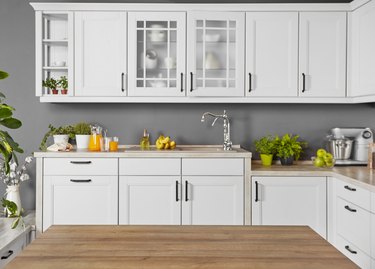The doors to your kitchen cabinets have to go through a lot. The kitchen can develop an atmosphere which is rife with grease, dust and airborne food particles. There are a variety of methods for cleaning this kitchen buildup from cabinet doors. Getting the cleaning process right depends on the severity of the greasy buildup as well as the material of your kitchen cabinets.

Homemade Remedies for Cleaning Kitchen Cabinets
If your kitchen cabinet doors are only lightly soiled, you may be able to remove the residue using some common household items. Note that if the doors are particularly soiled, greasy and sticky, you may wish to use a stronger solution.
Video of the Day
Video of the Day
You can use a slightly acidic remedy to cut through light grease. Mixing one part lemon juice or vinegar with four parts water in a spray bottle can help you deal with targeted grease removal. If you want to perform a light, all-over clean, you can use regular dish soap and a sponge. Make sure to rinse your cabinet doors afterward to fully remove the cleaning product.
Cleaning Sticky Wood Cabinets That Are Painted
Wooden cabinet doors require a little more care than a plastic or laminate cabinet. However, wooden cabinets designed for use in kitchens tend to be treated to handle more hard wear and can likely stand up to a stronger commercial cleaning product. If you're unsure, you can perform a patch test toward the back of a cabinet to check the efficacy and safety.
One great choice is an oil soap. While it has a strong chemical scent, it can be diluted to a safe concentration even for painted wood cabinets. If you've tried cleaning with soap and are still unsatisfied with the cleanliness of your cupboards, you can make a more intensive stain remover by mixing baking soda and vinegar to form a paste. The reaction between these two ingredients will foam and eat away at the greasy residue. Apply on the affected areas, and then leave the paste to dry. It should draw out the grease as it does so. You can then remove the residual powder with a soft brush and rinse with warm water.
Finish your wooden cabinet cleaning process by applying wood polish. Not only does this give an attractive luster to your wooden cabinets, but it can also protect them for easier cleaning in the future.
Removing Grease From Nonwooden Cabinets
Nonwooden cabinets, such as those made of melamine, can usually stand up to a stronger commercial cleaning product. Mix a heavy-duty cleaning agent, such as Lestoil heavy-duty multipurpose cleaner, according to the directions on the bottle. Anything designed to tackle grease will likely make an effective degreaser for kitchen cabinets.
It's best to start with a weaker concentration and work your way up in order to prevent potential damage to your cabinets. Mix a weaker solution, and then add more of your cleaner as needed, never exceeding the concentration stated in the instructions.
Apply your cleaning solution with a sponge and allow it one or two minutes to work into the grease. You can scrub at any particularly tough stains with a soft-bristled brush, such as a dish brush. Remove the solution with a damp sponge and check the results. You can repeat the process if needed.
Once you're satisfied with the grease removal, you'll need to thoroughly rinse your cabinets to fully remove the cleaner. Residual cleaner can cause damage to your cabinet doors, so make sure to thoroughly rinse with a sponge dampened in warm water.